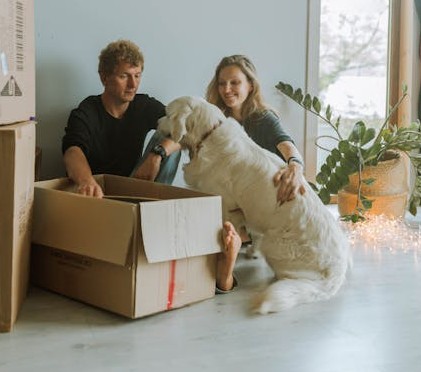The top concern when moving with a pet is managing their stress and anxiety, because for a pet, moving is a profound and confusing disruption of their routine and territory. Unlike humans, pets don’t understand that the upheaval is temporary and that there is a new, safe home waiting. This can lead to behavioral issues and even health problems.
Below are some tips on how you should handle your pet after the relocation process:
Help Your Pet Adapt
Take your pet to the new home in your own vehicle. Some animals feel more comfortable when moving in a vehicle they are used to. The small pets, like a cat and a puppy, can be put in a carrier, which is then secured with a seatbelt. A bigger pet like a dog can be moved in a kennel at the back of the car. Put the seat down if possible so that the pet cannot see the environment changing outside. Once the pet is in the car, do not open the kennel until it is in the new home. At the destination, be careful not to let your furry friend roam outside; he can easily get lost. Give him a few days to adjust to the new environment by walking him around the premises.
Help Your Pet Settle In
Talk to your pet about the move. It will surprise you how much better the pet will handle things when included in the dialogue. The calm in your voice will convince him/her that everything is ok and that there is no need for fear. Just like your kids, your pet likes routine and schedule. It is good if you stick to what your pet knows as his normal daily routine. This helps him/her adjust much more easily. Take your pet for a walk, engage in play and feed your pet at the same time as before you moved. Most pets, including dogs, crave normalcy and familiar smells, people and things. Carry their old toys, blankets and bedding. Show him/her around the new space and point to where he/she will sleep. This will easily help your pet settle into the new home.
Take the Week Off
Regardless of the kind of pet you have, adjusting to the new home environment is tough. Knowing your pet’s demeanor, whether confident, shy or social, helps you understand their individual needs so you can easily provide the comfort they need. Allow yourself to spend some time with your pet before you get busy in the new setting. Spend some of your time away from your house in small increments to see how your pet will respond. Eventually, when you start working, your pet will adjust to the environment and be more comfortable alone.
In short, moving is a stressful process, and it will impact your pet. Ensure that the process is smooth for them and be there for as long as you can for them.
Special Note: In a decade of moving customers across Oklahoma, we had one pet locked in a K-BOX. A cat snuck in when it’s owner wasn’t looking and she called us frantic on a Sunday to access her K-BOX in storage. Please do not ever pack animals inside portable moving and storage containers.

